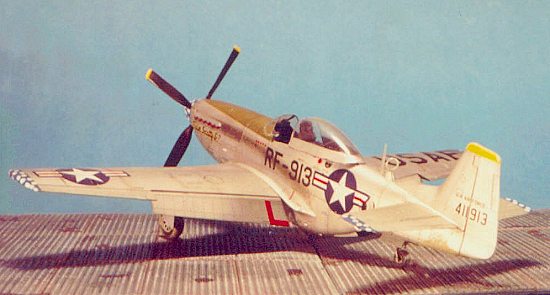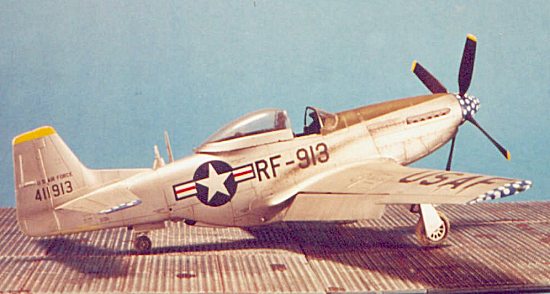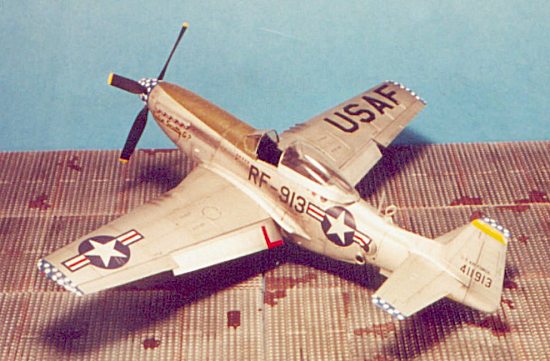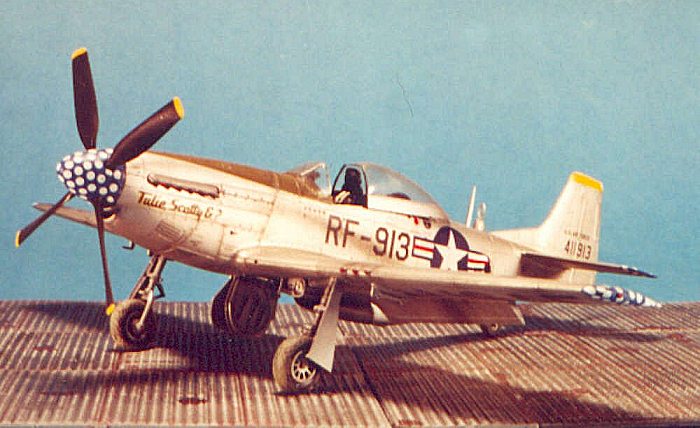
|
KIT # |
61044 |
|
PRICE: |
$23.00 |
|
DECALS: |
One aircraft |
|
REVIEW & |
|
|
NOTES: |
Conversion |
PEEPING PONY - THE RF-51D MUSTANG IN KOREA
Modeling an RF-51D of the 45th Tactical Recon Squadron

|
HISTORY |
The Man and the Airplane:
Anyone who has been involved with old airplanes in southern California in the last fifty-odd years has very likely at least heard of Rev. B.C. Reed, if not met him at an air show somewhere; I first met him at the 1978 Merced Antique Airplane Fly-In; he was leaning against Bill Turner's replica Gee Bee "Z" Super Sportster, telling Bill "You know, you're gonna kill yourself in this contraption." (He was almost right: Bill ground looped the killer later that day landing back at Half Moon Bay Airport, ending up upside down in a ditch; he never flew it again and today it hangs from the ceiling of the Santa Monica Museum of Flying.) I've known B.C. off and on over the years at antique airplane shows and out at the Planes of Fame Air Museum; among other things he's done for the museum was to deliver "Spam Can" in March, 1957. It was the Museum's first flyable airplane and is now the oldest privately-owned P-51D in the world.
 An airplane nut's
airplane nut, young B.C. first started taking pictures of airplanes at the 1927
National Air Races at Mines Field; he once photographed Charles Lindbergh when
the famous flyer visited Southern California. In 1940, B.C. achieved his life's
dream by being accepted as an aviation cadet in the U.S. Army Air Corps. The Air
Force, in its infinite wisdom, decided that Cadet Reed's skill with a camera
merited further effort, and B.C. found himself in the 107th Tactical
Reconnaissance Squadron of the 67th Tac Recce Group, flying F-6As (the recon
version of the P-51A) with the Ninth Air Force in France, the low countries and
Germany after the Normandy Invasion; he says the Allison Mustang was the most
fun to fly of all the North American ponies. B.C. stayed around his beloved
Mustangs after the war as a member of the Air Force Reserve, and on 3 September
1950, MAJ B.C. Reed found himself assigned to the 45th Tactical Recce Squadron,
once again part of the 67th Tac Recce Wing. They were in Itazuke Japan, under
the command of his old C.O., the legendary LCOL Karl Polifka, the man who
invented tac recon for the USAAF. The Mustang they were using this time was the
RF-51D, one of the least-known versions of the North American pony - and one of
the more important.
An airplane nut's
airplane nut, young B.C. first started taking pictures of airplanes at the 1927
National Air Races at Mines Field; he once photographed Charles Lindbergh when
the famous flyer visited Southern California. In 1940, B.C. achieved his life's
dream by being accepted as an aviation cadet in the U.S. Army Air Corps. The Air
Force, in its infinite wisdom, decided that Cadet Reed's skill with a camera
merited further effort, and B.C. found himself in the 107th Tactical
Reconnaissance Squadron of the 67th Tac Recce Group, flying F-6As (the recon
version of the P-51A) with the Ninth Air Force in France, the low countries and
Germany after the Normandy Invasion; he says the Allison Mustang was the most
fun to fly of all the North American ponies. B.C. stayed around his beloved
Mustangs after the war as a member of the Air Force Reserve, and on 3 September
1950, MAJ B.C. Reed found himself assigned to the 45th Tactical Recce Squadron,
once again part of the 67th Tac Recce Wing. They were in Itazuke Japan, under
the command of his old C.O., the legendary LCOL Karl Polifka, the man who
invented tac recon for the USAAF. The Mustang they were using this time was the
RF-51D, one of the least-known versions of the North American pony - and one of
the more important.
The job of tac recce is dangerous: you're down low, looking for people and things that don't want to be found, before they shoot you down (hopefully). The job of the 45th TRS was to cover the front line area with visual and photographic reconnaissance. During the advance and later the retreat of U.N. forces into and out of North Korea that fall and winter, the unit also performed many deep penetrations for armed reconnaissance far north of the battle zone into what would become known as "MiG Alley." They were among the first Mustangs to be hunted by MiG-15s; it was only the fact that the unit pilots were experienced Second World War combat veterans that they were able to avoid losses in those combats.
 When the lines
stabilized around the 38th Parallel in 1951, the tacics changed. Operating from
K-2 at Taegu, two RF-51Ds would cover a given geographic area, one flying top
cover at 3,000 ft. and watching for ground fire while the other would drop down
to 300 ft. AGL and look for trouble. Given that a Mustang is a goner with a BB
in the radiator, losses were high. That spring, the unit perfected a new tactic,
the "circle 10." The idea was to fly a 10 mile radius circle around an
area where enemy vehicle activity was sighted the night before. Using the
"Corps Technique," each pilot was given an area he came to know like
the back of his hand; though all enemy road activity stopped at dawn, the pilots
would look for something out of place, something that hadn't been there the day
before. When they found what they were looking for, they brought in fighter
bombers, and inflicted high casualties. The Chinese Communists hated the
snoopers, and no recon pilot shot down behind enemy lines who wasn't immediately
rescued by UN forces ever made it to POW camp. By that summer, the T-6 "Mosquitos"
were taking heavy losses, and were restricted to flying missions no more than 2
miles north of the MLR; the 45th's RF-51Ds took up the slack. On July 1, LCOL
Polifka was lost when he attempted to bail out of a shot-up Mustang, only to
have his parachute hang up on the rudder as it streamed and he was dragged to
his death in the crash.
When the lines
stabilized around the 38th Parallel in 1951, the tacics changed. Operating from
K-2 at Taegu, two RF-51Ds would cover a given geographic area, one flying top
cover at 3,000 ft. and watching for ground fire while the other would drop down
to 300 ft. AGL and look for trouble. Given that a Mustang is a goner with a BB
in the radiator, losses were high. That spring, the unit perfected a new tactic,
the "circle 10." The idea was to fly a 10 mile radius circle around an
area where enemy vehicle activity was sighted the night before. Using the
"Corps Technique," each pilot was given an area he came to know like
the back of his hand; though all enemy road activity stopped at dawn, the pilots
would look for something out of place, something that hadn't been there the day
before. When they found what they were looking for, they brought in fighter
bombers, and inflicted high casualties. The Chinese Communists hated the
snoopers, and no recon pilot shot down behind enemy lines who wasn't immediately
rescued by UN forces ever made it to POW camp. By that summer, the T-6 "Mosquitos"
were taking heavy losses, and were restricted to flying missions no more than 2
miles north of the MLR; the 45th's RF-51Ds took up the slack. On July 1, LCOL
Polifka was lost when he attempted to bail out of a shot-up Mustang, only to
have his parachute hang up on the rudder as it streamed and he was dragged to
his death in the crash.
In August 1951, the 45th set up shop at K-14, Kimpo Air Base, where they continued to take a brutal beating from ground fire. In January 1952, minimum altitude was raised from 4,000 to 6,000 feet, and the recon flyers flew with escort to attack the AAA positions that opened fire on them. When the unit began exchanging their RF-51Ds for RF-80As in the fall of 1952, there were no more RF-51Ds in the Air Force outside of Korea, and the unit had suffered over 200 percent losses in two years of combat.
After the war - in which he'd survived two tours with the 45th TRS - B.C. left the Air Force and entered the Episcopal ministry, becoming Reverend B.C. Reed just before he flew the Mustang that would become "Spam Can" from Maxwell AFB, Alabama, to Ontario Airport, then the home of The Air Museum, "Planes of Fame." Almost all the photographs of RF-51Ds taken during the Korean War are the work of the boy who once photographed Charles Lindbergh. B.C.'s never tired of taking pictures of airplanes, and if you check your research library for the photo credits, it's for certain you'll find at least one "Photo: B.C. Reed" in there. He's the kind of guy who's proof that "flyers are better people," all evidence to the contrary disregarded.
|
THE KIT |
 As a major "Mustang
nut" with 20 models in my collection and another 40 Mustangs I have made on
display out at "Planes of Fame," I have long thought of doing a recon
Mustang. Aeromaster released a sheet of Korean F-51s that included a very
colorful airplane of the 45th TRS. In fact, the airplane is just a little bit
"nutty" in its markings, with white polka dots over medium blue
spinner, rudder, wingtips and elevator tips. I asked B.C. about the provenance
of the markings and he told me, "You think people crazy enough to fly that
mission are going to have 'proper' airplanes?" B.C. Reed never had an
airplane of his own in Korea, but his logbook shows he did indeed fly 14
missions in RF-51D 44-11913, "Tulie, Scottie &..." The name came
from the original pilot, a man whose wife was pregnant when he left for Korea.
He was lost in another airplane before his child was born; no one in the
squadron could bring themselves to change the name.
As a major "Mustang
nut" with 20 models in my collection and another 40 Mustangs I have made on
display out at "Planes of Fame," I have long thought of doing a recon
Mustang. Aeromaster released a sheet of Korean F-51s that included a very
colorful airplane of the 45th TRS. In fact, the airplane is just a little bit
"nutty" in its markings, with white polka dots over medium blue
spinner, rudder, wingtips and elevator tips. I asked B.C. about the provenance
of the markings and he told me, "You think people crazy enough to fly that
mission are going to have 'proper' airplanes?" B.C. Reed never had an
airplane of his own in Korea, but his logbook shows he did indeed fly 14
missions in RF-51D 44-11913, "Tulie, Scottie &..." The name came
from the original pilot, a man whose wife was pregnant when he left for Korea.
He was lost in another airplane before his child was born; no one in the
squadron could bring themselves to change the name.
When my Parisian friend Sebastien Privat sent me a Tamiya P-51 with resin parts for an F-6A/RF-51D, the die was cast. (The French distributor for Tamiya does these limited run kits with resin parts and "Decals Carpena" decals, much like what Hasegawa does here with their limited-run kits with Jaguar resin parts; these aren't exported, so if you have a modeler friend in France, see if you can't get them.) Despite the very nice Carpena sheet for three French air force F-6A's, I knew this one had to be a 45th TRS bird.
|
CONSTRUCTION |
What can I say? It's Tamiya! Follow the instructions and get a great model. Buy the beautiful True Details resin cockpit and the Squadron vacform canopy for the Tamiya kit, and it's even better, no matter what version you're doing.
The Conversion:
Unfortunately, the first thing I realized on test-fitting the resin parts - they're the camera ports on the port side - was that except for the large bulged port right at the end of the fuselage insignia, the others were too big. After thinking about this for awhile, I ended up using some Evergreen plastic tubes, cut appropriately, and then filled with Micro Krystal Kleer, to create the other camera ports. I also used a loop antenna from a Hasegawa Mustang kit. Do remember that USAF Mustangs in Korea had black cockpits, and that most of them used the uncuffed paddle Hamilton-Standard prop blades that come with the Tamiya F-51D Korean Mustang. The cuffed blades were there, too, so check the pictures.
|
PAINT & DECALS |
 Painting:
Painting:
Originally, Mustangs were in Natural Metal Finish, other than the wings, which were painted with aluminum lacquer to try and maintain the laminar airfoil. By the time of Korea, Mustangs were getting old and corrosion was a problem. Most of those that fought through the war were painted overall in aluminum lacquer, which is why they looked as ratty as they do in the photos. Some "experts" say that if you see a Mustang with panels around the exhaust a different shade from the rest of the airplane, you are looking at an NMF airplane. Not true! Due to the exhaust burning of the metal, those panels were never painted on any Mustang. If you are trying to figure out if the airplane you are doing is NMF or painted, look at the area around the radiator: if there are different-colored panels just below the national insignia, the chances are it is NMF. Otherwise, it's overall aluminum lacquer. Maybe. The paint weathered atrociously; these were ponies who were "ridden hard and put out to pasture wet" in the old cavalryman's phrase.
All of the RF-51Ds used in Korea were painted in overall aluminum lacquer. The trick is to weather them appropriately. I pre-shaded my model with Tamiya gloss black, then shot very thin coats of SnJ Aluminum over, leaving the shadowing of the undercoat to mar the lacquer. I gave it a shot of "Future" for decals, after which I gave it an overall flat finish, after using Tamiya "Smoke" to simulate oil smears, exhaust stains, and further weathering of the paint.
Decals:
With the model prepared, the Aeromaster decals went down with no problem. I used a SuperScale Sheet of USAF Medium Blue for the markings. The Aeromaster sheet provides a lot of little white dots for the polka-dotting. Don't worry about getting it "right": there was no "correct" pattern - just put dots all over the blue.
Final Finish:
Once all the decals were set up, I sealed them with another coat of Future, then shot the model overall with "Flat Future," a mix of 70 percent Future, 30 percent Tamiya "Flat Base", applied in several thin coats until it was the "sort of" flat I wanted.
The canopy had been dipped in Future before it was cut out and painted. It was now attached with Elmer's Glue, a commonly-available white glue. The landing gear was also attached; I always "muddy up" the wheels; I impale them on an xacto knife, then paint them with a thinned-out "muddy brown" color which varies from model to model. The trick is to get it thin, so you see the tread. The result is that wheels are more than mere black blobs.

|
CONCLUSIONS |
As somone who has been privileged to spend a lot of time around 1:1 Mustangs over the past 30 years, I can say that Tamiya's 1/48 Mustang is the best - it looks "real" when finished, particularly with the dropped flaps. I really like my "peeping pony," which is a very different Mustang.
If you would like your product reviewed fairly and fairly quickly, please contact the editor or see other details in the Note to Contributors.